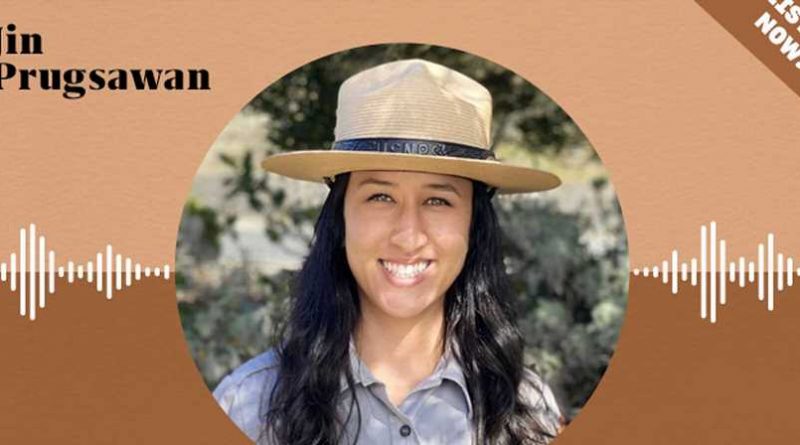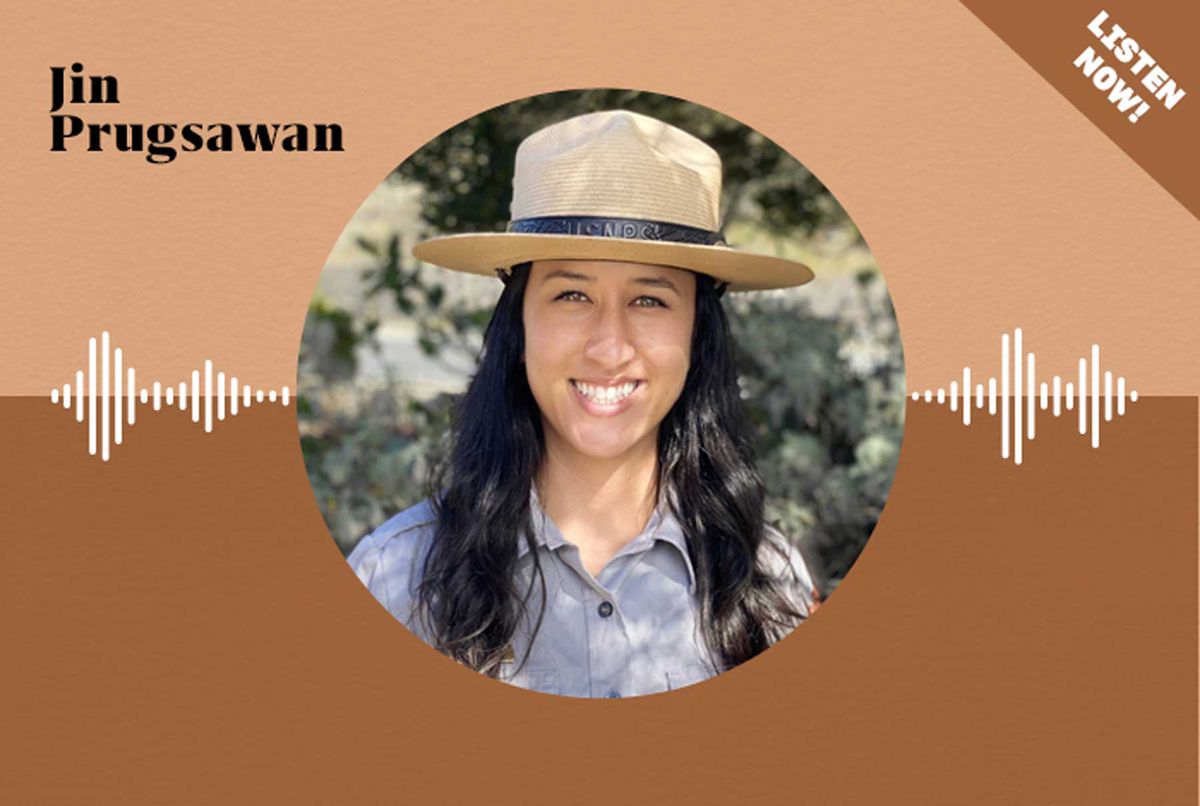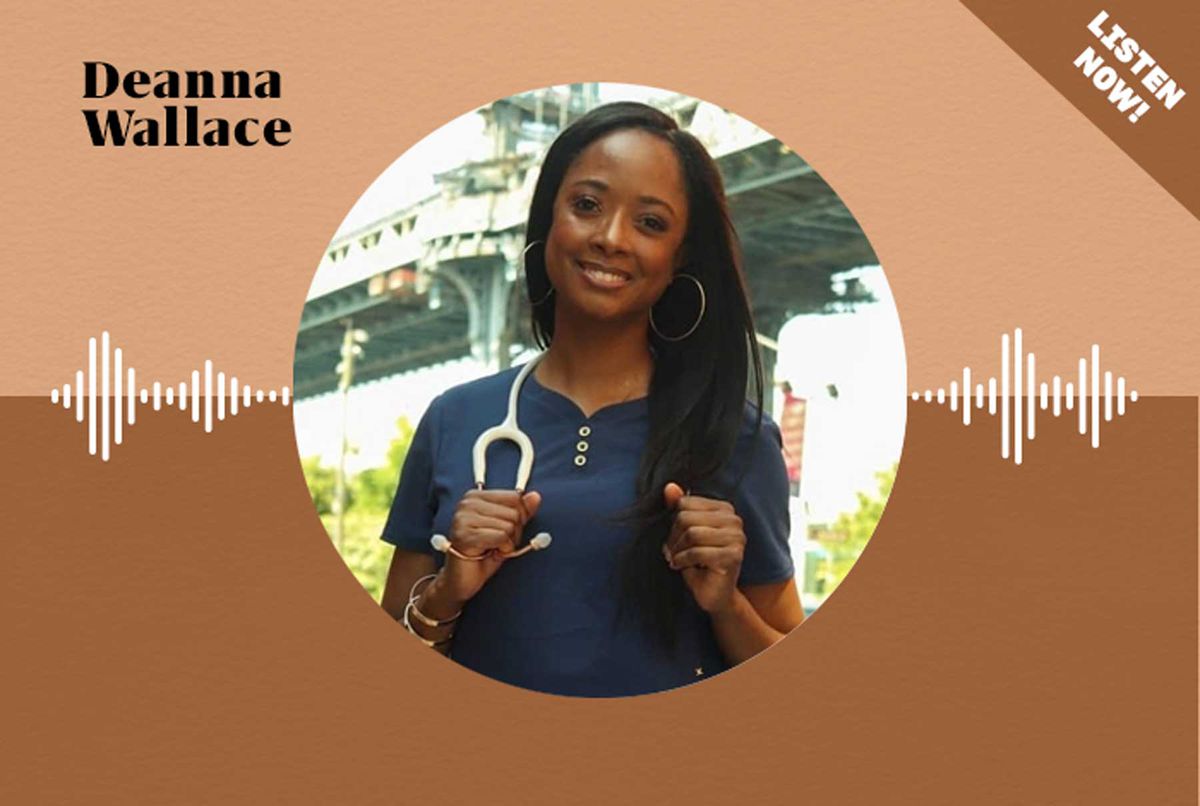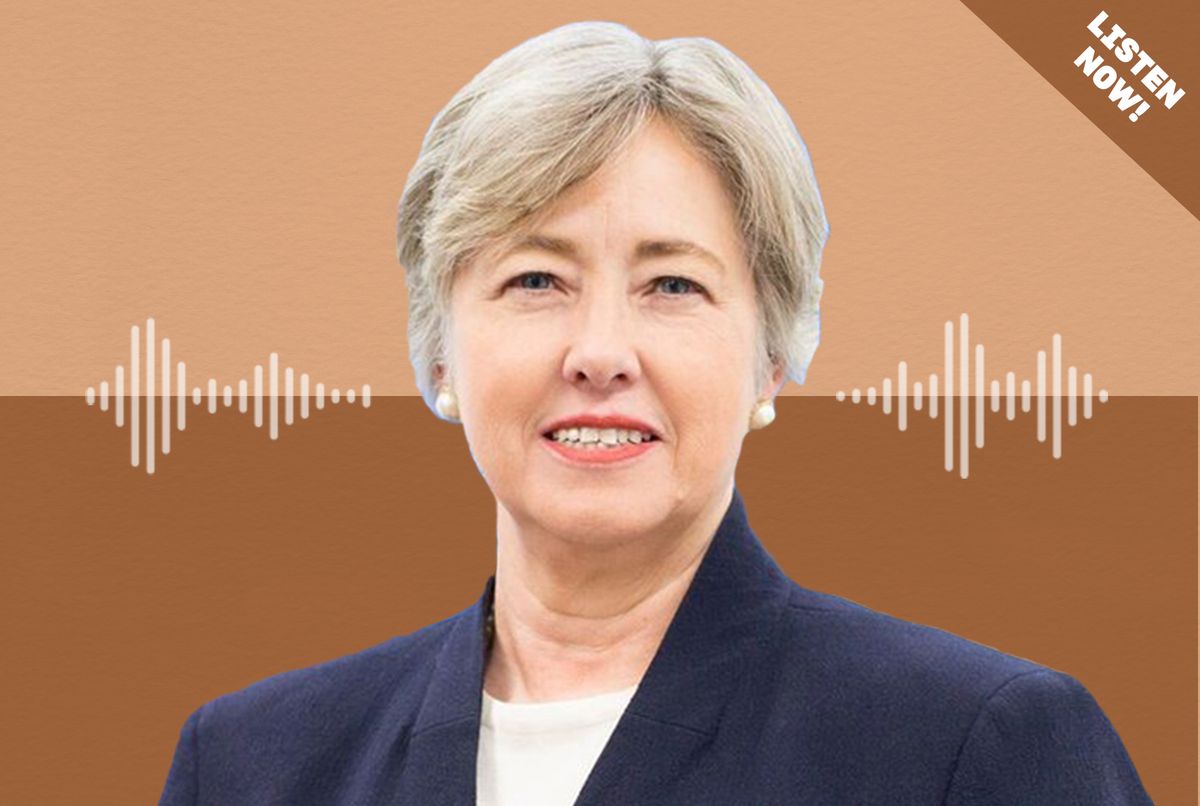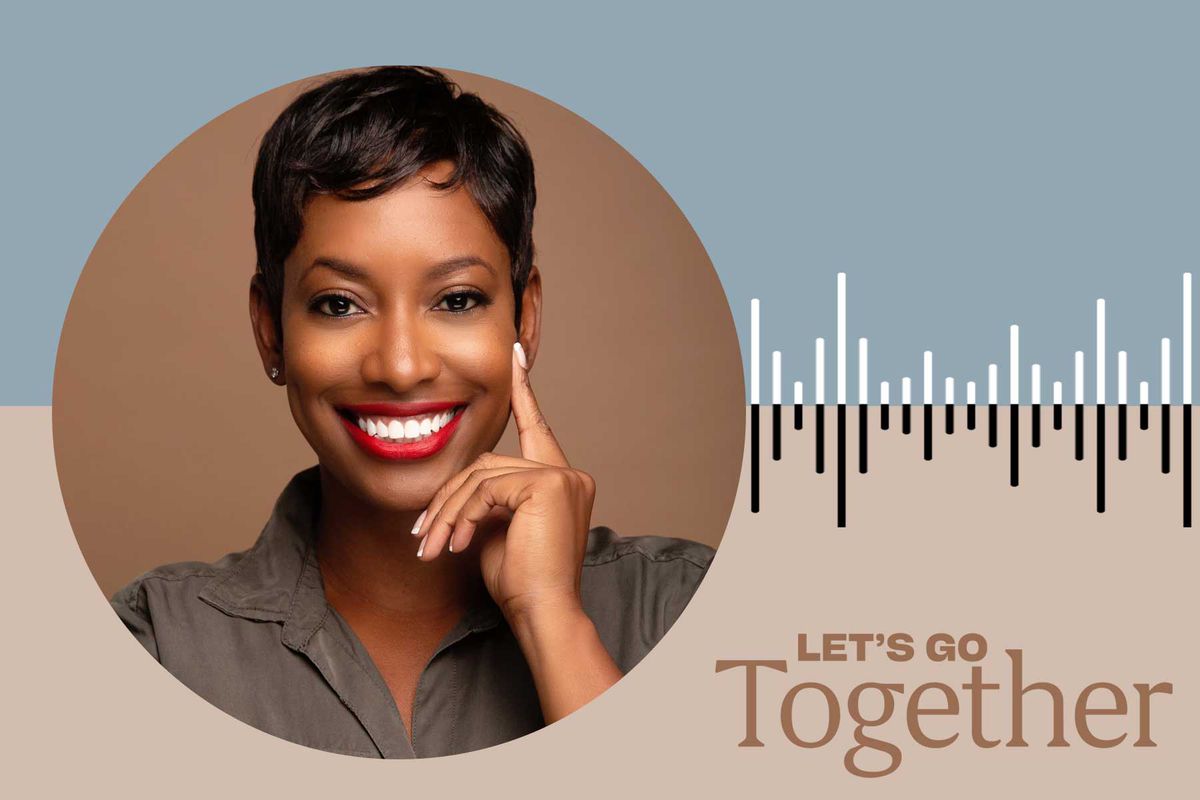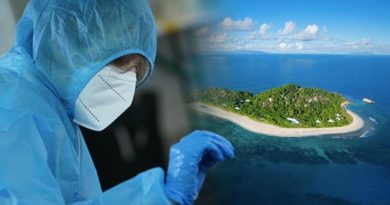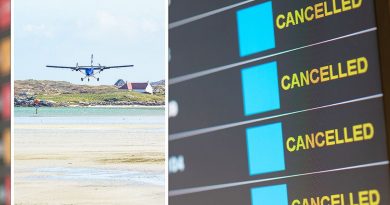Meet the Female Park Ranger Redefining the Role in Hawaii: Season 2, Episode 3 of 'Let's Go Together'
Travel has most certainly changed over the last year. Rather than jetting off to the far corners of the earth, many of us have stayed put, hunkering down for the greater good. However, a return to travel appears to be on the horizon, and we're celebrating with all-new episodes of our podcast, Let's Go Together, which highlights how travel changes the way we see ourselves and the world.
In the first season, our pilot and adventurer host Kellee Edwards introduced listeners to diverse globe-trotters who showed us that travelers come in all shapes and sizes and from all walks of life. From the first black woman to travel to every country on Earth to a man who trekked to Machu Picchu in a wheelchair, we met some incredible folks. And now, in our second season, Edwards is back to introduce you to new people, new places, and new perspectives.
In our latest episode, Edwards speaks to Jin Prugsawan, chief of interpretation, education, and volunteers at Haleakalā National Park in Hawaii. Prugsawan shares her experiences as a female Park Ranger in the National Parks Service (NPS), including walking on day-old land and reuniting with long lost family members.
"I love being able to tell some of the stories of working at that park. And it's not just, 'this is a place that I go and I can hike here.' But, 'this is a place that was really significant and important to Hawaiians and still is today,'" Prugsawan shares in the episode. "The highest point in Haleakalā is called the [Wao Akua], which is the realm of the gods. And it was a sacred area for Hawaiians to go to. And I think when you can just open up and share a little bit more about the park and about the stories and the different meanings and people who have made connections to those places, it's fun to share those stories."
Prugsawan is also acutely aware of the importance of her job placement, and to show young women who look like her that this is indeed a job for them as well.
"As a young woman who's diverse, I didn't see myself reflected in park management and I didn't see myself reflected even in the supervisors that supervised me or trained me," she shares. "And that was really challenging to see. But today, things look a little bit different for me, Haleakalā, and the people directly under me, the supervisors that I supervise. I'm pretty proud to say that all of them are women and all of them are diverse women. And that's been a really big departure across the agency."
Hear more from Prugsawan and Edwards about the park and everything you can find there on Let's Go Together, available on Apple Podcasts, Spotify, Player.FM, and everywhere podcasts are available.
—–Transcript—–
Kellee: (script) Hi, my name is Kellee Edwards…and this is Let's Go Together, a podcast from Travel + Leisure about the ways travel connects us, and what happens when you don't let anything stop you from seeing the world.
For nearly a century, America's National Parks System has preserved the country's natural and cultural resources. Encompassing 423 areas, including national parks, monuments, battlefields, historic sites, scenic rivers, and even the White House. And the people entrusted to protect and manage these areas are the National Parks Service.
On this episode, we hear from Jin (Prag-sah-wan), a veteran park ranger with the National Parks Service, now working at Hawaii's (Holly-aah-ka-la) National Park. She talks about volcanic lava flows, the hike in Yosemite that taught her to always be prepared, and leadership as an Asian woman in the National Parks Service.
Interview
Jin [00:01:06],My name is Jin Prugsawan and I am the chief of interpretation, education and volunteers at Haleakala National Park.
Jin [00:01:26] I manage the division that's responsible for all visitor engagement at our park from our park website to the signs that you see in the park as you're hiking through out to the park ranger that you encounter in the visitor center. Who's helping you plan your trip or your experience in the park? There's a lot of different things that fall under that umbrella of interpretation. But if you think of it in a way of anything the public interacts with or faces that falls into my division. We also manage the parks education programs where we are able to bring kids into our parks or go out and send rangers into the classroom to educate kids about our national parks. I also manage the volunteer program and we have lots of different volunteer opportunities in our park.
[00:45:58] A question that I love to get from visitors, are the questions that really dig into the story of the park that you're at, the questions that, you know, tell the story of why this place was preserved or why it's important working at Haleakala? You know, I love telling being able to tell some of the stories of working at that park. And it's not just, you know, this is a place that I go and I can hike here. But, you know, this is a place that was really significant and important to Hawaiians and still is today. And the most, you know, the highest point in Haleakala is called the Vorkuta, which is the realm of the gods. And it was a sacred area for Hawaiians to go to. And I think when you can just open up and share a little bit more, you know, about the park and about the stories and the different meanings and people who have made connections to those places, it's fun to share those stories.
[00:46:59] I have a memory of sitting down with a young family that came up to me. And, you know, this little girl, she was very young. She asked me to tell her a story. And I remember we sat in the side of the trail on a log and I shared with her every story that I could think of that she would be interested in. And it was just really fun to, you know, connect on a deeper level. And as a park ranger, you know, you learn so much about your park from the plants, the animals, the stories, the people. And it feels really good to be able to share those things with people.
I started my journey with the National Park Service 14 years ago.
I started out as the unpaid intern and I moved up to being a seasonal and a student hire, doing interpretation and talking to park visitors, leading tours in the park. And I've moved my way up to supervisor and now division chief. So I've had, you know, and I guess in the set up of the National Park Service, I've climbed in the ranks. But even within, you know, those duties that I had, I also had a lot of different collateral duties. So I've assisted with search and rescue. I was a structural firefighter. I do public information for wildfires. I've worn many other hats in the National Park Service as well.
I was in high school and we had a semester of class work and then a semester of an internship. And for my internship, I was completely taken away by Arlington House. The Robert E Lee memorial. And I'll totally admit is because they were period clothing and I really wanted to wear a hoop skirt. That was sort of my introduction to it. But during the course of my internship, you know, I saw this as a career opportunity and that many of the interns that had worked at Arlington House went on to be Summer Seasonals, where they're employed by the National Park Service. And, I was a senior in high school at the time. I was getting ready for graduation. I wasn't sure exactly what I wanted to do in terms of career path, but I really enjoyed, the work that I was doing at Arlington House and talking to people. I love history. So it was just a really wonderful opportunity. And in the same vein, you know, I came from a single parent household, so taking on an unpaid internship was really challenging. But with the idea that I could have a position and a job, you know, after that summer was really something I was pursuing and wasn't in retail. It was actually doing something I enjoyed. So that's that's really what got me started with the National Park Service. And I was really proud after graduation from high school and I was enrolled to go to George Mason University to wear my flat hat for the first time.
I was always somebody who liked to be outside and playing in the forest or playing in the water. I would say water is my element, but I never grew up going to national parks. I didn't know what the National Park Service was until, you know, the park ranger walked into the classroom of my senior year to present Arlington House as an internship opportunity. I had no idea that the National Park Service had sites all around the country. I grew up a little bit of all over. I lived in Michigan, Florida and Virginia and Michigan and Virginia during my high school years. And I had no idea that Sleeping Bear Dunes was part of the National Park Service until I was looking through the Red Book, where they list all of the national parks and like a sentence about them. And I was flipping through this book and I was like, oh, like sleeping bear dunes. Like I grew up there. We used to go camping there when I was a little kid, but I never met a park ranger, at least that I remember or know about. I'm going to almost hate probably saying this because everybody in Yosemite will be mad. But when I read the name Yosemite National Park, I looked over to my supervisor and I said, Oh, Yoz-Mite, that. Sounds really interesting but what is that. And he laughed at me and corrected me. It was Yosemite and then a year later I worked there as a seasonal and I really got to see what the National Park Service was all about and working at a historic site in Washington, D.C. and then going to one of the big national parks out west. It changed my life and I had never seen mountains, never seen waterfalls, anything close to what Yosemite held. And from that point on, you know, I was 19 years old and I knew I wanted to pursue a career in the National Park Service. And I got really serious to trying to figure out how to make that happen.
Prior to coming to Maui, I lived in North Carolina and I worked at Wright Brothers National Memorial. And while I was at Wright Brothers National Memorial and this is, you know, a really remote area in the Outer Banks, you know, you're just kind of in this thin little slice of islands that juts out into the Atlantic. And, you know, it's a different lifestyle out there. But working at Wright Brothers for me was just a really cool experience because I was able to help with the exhibit project and they installed brand new exhibits into the visitor center. And this is a multi-year project that I worked on. And it took a lot of hours to ensure the accuracy.
You know, are we telling the stories of the Wright brothers correctly? It's not just about their flight, but everything that led up to that point. It was the people who lived in the Outer Banks community, you know, that helped them and made sure that they had the supplies and the resources and the different access that they needed for that first flight and then are retelling diverse stories of the other folks that maybe history has glossed over as part of that.
I think one of the stories that really resonated with me was that the Wright brothers really cared about women's rights. And there was a story about or I think it was Orville Wright marching with his sister Catherine in one of the women's rights marches in Dayton. And, you know, I thought that was such an interesting part of her of the Wright brothers story. You know, we think of the brothers, but we don't think of their siblings. And they had a sister that they were really close with and not just, you know, an age or in kind of kinship that you have with your siblings, but also shared some of the same values.
Kellee: Jin has experienced many amazing things as a Park Ranger, including walking on land, freshly formed from a lava flow, that's barely a few days old.
Jin [00:30:56] While I was at Hawaii Volcanoes National Park, I spent the first two weeks in training and we covered the hard questions like where is the bathroom to some of the more challenging questions out there, you know, talking about where these different lava flows are happening in the park and how can people safely view them. And in part of that training, we were able to go out with a volcanologist, with the USGS and that was a really cool experience because they talked about the different the flows going on in the park, the different statuses, you know, of the volcano and some of the volcanic activity going on and some of the features that you see as well. And we, you know, with the volcanologists were able to go out to an area where you could see active lava flow. And we started hiking out there around sunset. So we would have lighting that allowed us to see where we were going. And we reached a section of land that, you know, of course, the volcanologists is the one leading the hike. They're very experienced. They know what to look for because it can be really hazardous when you're hiking on volcanic land, especially volcanic land that, you know, has active flow in that area. And we started walking in a section where he told us, you know, hey, this land is about, you know, maybe a day old, maybe a little bit older than that, but not that old at all. And sure enough, as we're hiking along and he's, you know, guiding us on the path, you could look down into the cracks. And on the surface, everything was black. It was hardened, but deep in the cracks, you could see where some of that lava was still red hot. And that was a wild experience to be walking in that area.
I definitely felt the heat radiating up. You know, it was already warm because you're near the coast in Hawaii. So the temperature is warm all around you already. But the ground itself is warm and it's sort of the same to me, equated to the same warmth that you'd feel if you had your feet up close to a campfire. You know, that warmth that you start to feel in the bottom of your shoe. And if you stood any, you know, any spot for too long, you know, you could really feel some of that warmth coming up.
But I don't advise that anybody just blindly goes and walks on land less than a day old. You know, make sure that you're in an area that's safe and you know that you're sanctioned to be there because people have gotten hurt and injured in the past and they've walked into different lava flow areas.
Kellee: After the break, Jin shares her experiences of working as a woman of color in the National Parks Service, as well as how she reconnected with a long-lost family member.
—–Break—–
Kellee: I'm Kellee Edwards, and this is Let's Go Together from Travel + Leisure. Jin is a 19-year-veteran of the National Parks Service. As a Thai American woman of color, diversity is something that is top of mind for Jin, especially as a leader in the service.
Jin [00:16:01] I think I've always worked with women in the National Park Service, but where I would say I've noticed one of the biggest differences is women in leadership roles, you know, maybe in the front line or in those entry level positions. It could be more of an even playing field. But I remember really early on in my career going to a training where they told us the majority of positions that were in management level positions or above, you know, whether that's mid-level management or higher. They were held by white males over the age of 40. And when I heard this, I was, you know, in my early 20s and it was really upsetting, even now that I say I still just makes my blood boil to think of our society and, you know, the diversity that we have. But the majority of management positions in the National Park Service were held by white males over the age of 40. And as a young woman who's diverse, I, I didn't see myself reflected in park management and I didn't see myself reflected even in the supervisors, that supervised me or trained me. And that was really challenging to see. But today, you know, things look a little bit different for me, Haleakala and the people, you know, directly under me, the supervisors that I supervise. You know, I'm pretty proud to say that all of them are women and all of them are diverse women. And that's been a really big departure, I think, across the agency overall, there's room to grow. And I think there needs to be a lot more change because I have worked in parks, you know, especially parks out west or, you know, other areas where there's not as much diversity. And oftentimes I would feel like I was the only Asian person in the room and, you know, sometimes only the only Asian person in the park. And I think it makes a big difference when you have diversity reflected in your staff, not just for the people who work there, but the people who are going to our national parks and experiencing them.
I had a moment where one of my coworkers who was black or who was black at Great Falls Park in Virginia, we were working on an exhibit together. And in the exhibit we were talking about water bottles and the use of water bottles and how people should switch from disposable to reusable. And we were working on the images and we wanted to make sure that that we reflected diversity in it. And, you know, we took a picture and it was me staged in an area in the park and I was drinking out of a water bottle. But, you know, as an Asian woman, you know, that's reflected in this exhibit. And I had moved on from that park and maybe two or three years later, he sent me a picture of an Asian family standing in front of that water bottle exhibit, refilling their water bottles. And he said representation matters. And I think about that a lot because, you know, how do we display what we have in the National Park Service and what's who's welcome in the National Park Service or in our national parks? And the outdoors is for everyone, but I think there is a barrier for people of color when we go to National Parks, because maybe we don't come from families that have spent a lot of time in the outdoors. So we don't know exactly what to expect when we go and venture to these places ourselves.
When I think of people of color exploring our parks, you know, do they have those same experiences and you know, or do they have, you know, the access to the resources where people can teach them, hey, this is how you go backpacking. This is what to expect when you're sleeping in the outdoors and under the stars and that it's not scary, but it can be a fun experience as long as you're prepared.
One of the experiences that I had in Yosemite for the first time, I had never gone hiking before for multiple miles. You know, for me, it was like, oh, I'm going for a walk in a park. And, you know, even though I was a park ranger at Great Falls Park in Northern Virginia, you know, it was just a couple of miles long for our trails. You know, I wasn't seeking out trails that were multiple miles and tough landscape. I remember one of my friends in Yosemite right when I first arrived, told me to hike a really tough trail while I was there. And I had a total kind of new experience to hiking when I realized I was completely unprepared with not enough water, not enough resources, not enough food, all of these things to take on a multi, you know, mile hike that took multiple hours.
Man, I was so close to the top of that hike. It was you know, I think we probably had less than a mile to go, but I had completely run out of water. And I made a classic mistake thinking that all I needed to do was carry a big water bottle with me. I didn't bring a backpack. I'm ashamed to say it, but I just I really had no idea what I was getting into and I should have done my homework on it. But I remember I was hiking up the switchbacks. There was a sandy section on the trail. And I mean, it was just sheer drop offs, you know, appeared to me I was getting really dehydrated. And I just knew at that point that I couldn't let pride be the only thing keeping me going. And it would be more embarrassing that in my first week of work that I had to get rescued, you know, so I turned around and, you know, from there I learned, OK, if I'm going to go hiking, I want to have a backpack with me. I want to make sure someone knows where I'm hiking. I want to make sure that I have more water than I think I need. And then I have plenty of snacks because that's the fuel that keeps you going.
Kellee: Jin may have chanced upon her career as a Park Ranger, but conservation seems to be in her blood. While working as a park ranger, Jin was able to reunite with a long lost family member.
Jin [00:26:12] I was working in Yosemite National Park and there was a Thai delegation from National Parks in Thailand coming to visit. And my supervisor at the time told me, hey, like, you should really go and tag along with this group. And I told him I was like, you know, I'm not fluent in Thai, didn't grow up speaking Thai, so I can say hello. But beyond that, I'm not going to be much use. And my supervisor was like, no, just go. Anyway, I think you'll be great if you go and say what you know, but you don't have to translate. They have a translator with them and it'll just be nice if you go. So I went and, you know, I said sawadee kha and I talk to everybody as best as I could. And next thing I know, there's a man who comes up to me and he's staring at my nametag and he's pointing at his nametag and pointing at himself. And he doesn't speak English and I don't speak Thai, so I have no idea why he's like really looking at my nametag. And the translator comes up to us and she looks at him and starts talking to him and Thai. And then she looks back at me and she's like, oh, like he's your uncle. And I was like, What? And I had met my Thai family before. And I knew everyone who was, you know, a sibling of my dad. But this guy was brand new and I was really confused. And, you know, finally she was able to translate more and she said, you two share the same last name. He's a relative of yours. And, you know, that night I got on the phone with my dad and I was like, hey, who's this uncle I've never met? And it turns out that my dad had lost contact with this relative for over 20 years. And, I met him in Yosemite National Park, of all places. It turns out we are related. And it was just a really wild experience for my dad because he shared all these memories, you know, with my uncle and, you know, the experiences that they had growing up together in Thailand. So it was really cool to connect. And then that following year when I was in Thailand visiting my family, you know, we met up in Thailand and got to see each other again.
Kellee: Jin would later discover another amazing connection her family shares with conservation and parks
Jin [00:28:58] A couple of years later when I was at my Cunard's house, my grandmother's house in Thailand. And I saw this very official looking document that was like framed and up on a mantle. You know, I recognized like, oh, like these kind of looks like it's our last name, but I don't know what this is. And I asked and it turns out that that was given to my family from the king of Thailand for our last name and our last name, Prugsawan, it basically translated our last name to Forest Protector because I had a great, great uncle who was a forest protector in the Department of Ministry in Education in Thailand. And I had no idea that this relative even existed. I don't think my dad even knew about it or even put the two coins together that I would be interested in it. But it was really interesting for me to learn that, you know, after I had been a park ranger already for a few years now, that my last name is Forest Protector and I really felt like, wow, like I found my calling, like even my last name. It's almost destiny.
Kellee: As the country begins to emerge from the COVID-19 pandemic, Jin looks forward to welcoming visitors back to the parks
Jin [00:35:40] I would say in terms of planning a trip to a national park and this is what I would say before the pandemic or, you know, even during or after, you know, plan ahead and checking the park website to hear what the latest is on going on in that park, what type of opportunities and activities are available? Because each park is phased in in different phases of what's open, what's available and what's not. And the parks websites will tell you, hey, look, if you're visiting this park, here are some of the things to keep in mind. I think as long as people are planning in that way, you can still have a really great experience in your park. And again, I think that's what it takes, though, you know, before the pandemic, you always want to plan ahead and know what's open and what's available and what hikes are there and what there is to do and see while you're visiting.
The National Park Service has a great website. It's called nps.gov, like National Park Service dot gov. And from there, you can look at a map of all the different national parks across the country. There's over four hundred and twenty three, I believe, right now. And you can choose by state or you can look by region. However you want to explore the map and see all of the different national parks out there and national park websites, you know, they have really good suggestions on what people should do and what they should see and what there is to learn about that park just under your park website and the tip of your fingertips when you type that in.
For me, the national parks have been a way not where I can just find, you know, amazing places to visit or stories to connect to. But, you know, I think the people who work in national parks and I think that the people who go to national parks, there's almost this camaraderie that you feel with those people and an excitement or a shared excitement or moment that you can have with them when you visit parks. And I know for me, I I found the National Park Service, like I said, 14 years ago, I was really young. I was 18 years old, still in high school. Today I'm 32. And, you know, I felt like I was not able just to learn and grow in nature. But the friendships and the relationships that I've built because of the National Park Service and my experience of going to different parks and, you know, whether it's working or just on my own time to explore them, I've created so many lasting and wonderful memories. And I think that that's something that our national parks provide for anybody who goes to visit them as those memories that you have with the people that you experience them with.
Kellee: (script) That's all for this episode of Let's Go Together, a podcast by Travel + Leisure. I'm your host, Kellee Edwards. Our guest was Jin Prag-Sa-Wan of the National Parks Service. You can learn more about the National Parks Service by visiting their website at www.nps.gov Thanks to our production team at Pod People: Rachael King, Matt Sav, Danielle Roth, Lene Bech Sillisen, and Marvin Yueh [yu-eh]. Thanks also to the team at Travel and Leisure, Deanne Kaczerski, Nina Ruggiero, and Tanner Saunders. This show was recorded in Los Angeles, edited in New York City, and can be found wherever you get your podcasts. You can find out more at travel and leisure dot com slash podcast. You can find Travel + Leisure IG @travelandleisure, on Twitter @travelleisure, on TikTik @travelandleisuremag, and you can find me at @kelleesetgo.
Source: Read Full Article
